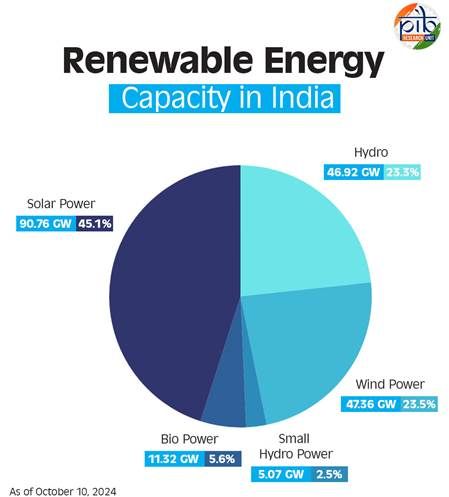Current Affairs 2024 - Wind Energy Generation in India: Potential, Policy, and the Path Forward
Feb, 2025
•4 min read
Introduction
As India steers toward its ambitious renewable energy goals, wind energy stands out as a promising resource. With expansive coastlines and vast open lands, India’s potential for wind energy generation is among the highest in the world. However, realizing this potential requires continuous improvement in technology, policy support, and investment. The Tamil Nadu Repowering, Refurbishment & Life Extension Policy for Wind Power Projects – 2024 is a landmark step toward addressing these needs and strengthening India’s wind energy infrastructure. This blog dives into the essentials of wind energy generation in India, exploring policy, technology, and future potential.

Tamil Nadu Repowering, Refurbishment & Life Extension Policy for Wind Power Projects – 2024
- Repowering: The replacement of old wind turbines with new, high-efficiency models. This involves installing turbines with greater power output and advanced technology on existing wind farm sites, enhancing energy generation without additional land.
- Refurbishment: The process of updating existing turbine parts to extend operational life and improve efficiency without full replacement.
- Life Extension: Extending the operational life of wind turbines beyond their original design life through maintenance, upgrades, and minor replacements.
The Tamil Nadu Repowering, Refurbishment & Life Extension Policy – 2024 is designed to support wind farm owners in upgrading aging turbines, thus optimizing energy production and leveraging existing infrastructure. This policy is commercially viable as it enables investors to generate higher power output from existing sites with minimal additional land use. By repowering, refurbishment, or extending turbine life, wind farm owners can reduce costs, increase energy yields, and contribute to India's energy security and sustainability goals.
Technology Behind Wind Turbines
Wind turbines harness the kinetic energy of wind and convert it into mechanical power, which is then transformed into electrical energy through a generator. The main components of a wind turbine include:
- Rotor Blades: Capture the wind’s energy and cause rotation.
- Nacelle: Houses the generator, gearbox, and other essential components.
- Generator: Converts the mechanical energy from the rotation of the blades into electricity.
- Tower: Elevates the turbine to catch higher-speed winds at greater altitudes.
- Control System: Ensures optimal alignment with the wind and manages operational safety.
Technological advancements, like the use of artificial intelligence for predictive maintenance and variable pitch control for rotor blades, have significantly improved turbine efficiency and reliability. Additionally, offshore wind farms are becoming more viable with floating turbines, which can capture the strong, steady winds over oceans.
National Wind Energy Capacity and Potential
India’s installed wind energy capacity stands at approximately 47.36 GW, making it one of the top wind energy producers globally. However, this capacity represents only a fraction of India’s total wind energy potential, which is estimated at around 302 GW at 100 meters height, 695 GW at 120 meters height, and 1164 GW at 150 meters height by the National Institute of Wind Energy (NIWE). Major wind-rich states like Tamil Nadu, Gujarat, Maharashtra, and Karnataka lead the way in wind energy production, and policies focused on repowering can further enhance these states’ output.
Wind Energy - India’s Renewable Energy Targets and SDG Goals

India aims to achieve 500 GW of non-fossil fuel energy capacity by 2030 as part of its renewable energy commitment. Wind energy is expected to play a substantial role in this target, with projections indicating at least 60 GW of wind capacity by 2030.
This aligns with several Sustainable Development Goals (SDGs):
- SDG 7: Ensuring affordable, reliable, sustainable, and modern energy for all.
- SDG 13: Taking urgent action to combat climate change and its impacts.
- SDG 8: Promoting sustainable economic growth and job creation.
Wind energy generation creates local jobs, from turbine manufacturing to site maintenance, and reduces dependence on fossil fuels. With supportive policies and infrastructure development, wind power could be pivotal in helping India achieve its renewable energy goals and contribute positively to global climate efforts.
Challenges and Solutions in Wind Energy Generation
Despite the advantages, several challenges impede wind energy growth in India:
- Land Availability and Cost: Wind farms require large tracts of land, often leading to high costs. Solution: Repowering existing sites, particularly in states like Tamil Nadu with old turbines, can maximize output without additional land use.
- Transmission Constraints: Wind farms, typically in remote areas, face issues with grid connectivity. Solution: Expanding grid infrastructure and upgrading transmission lines, especially under the Green Energy Corridor project, can alleviate these issues.
- Intermittent Nature of Wind: Wind is not consistent year-round, leading to fluctuations in power generation. Solution: Hybrid power systems, combining wind and solar power with energy storage, can help ensure stable energy supply.
- Environmental Impact: Large wind farms can impact local wildlife and ecosystems. Solution: Conducting environmental assessments and incorporating sustainable practices, such as avian detection technology, can mitigate these effects.
- Financial Constraints: High capital investment and lack of sufficient financing can deter investors. Solution: Government-backed subsidies, tax incentives, and favorable financing schemes can support the economic feasibility of wind energy projects.
Conclusion
Wind energy generation holds immense potential for India’s renewable energy landscape. With the right policies, like the Tamil Nadu Repowering, Refurbishment & Life Extension Policy – 2024, and continued technological innovation, India can harness wind power to its full capacity. While challenges remain, targeted solutions and support from both the government and private sector can propel India closer to its renewable energy and sustainable development goals. Investing in wind energy today paves the way for a cleaner, greener tomorrow.

![Aravali Range in News [UPSC 2025]](/_next/image?url=https%3A%2F%2Fblog-media.superkalam.com%2Faravali_hills_f4a51f37bf.jpeg&w=3840&q=75)
![MGNREGA Vs VB-G RAM G [UPSC 2025]](/_next/image?url=https%3A%2F%2Fblog-media.superkalam.com%2FMGNREGA_vs_GRAMG_ea46241736.jpeg&w=3840&q=75)